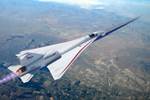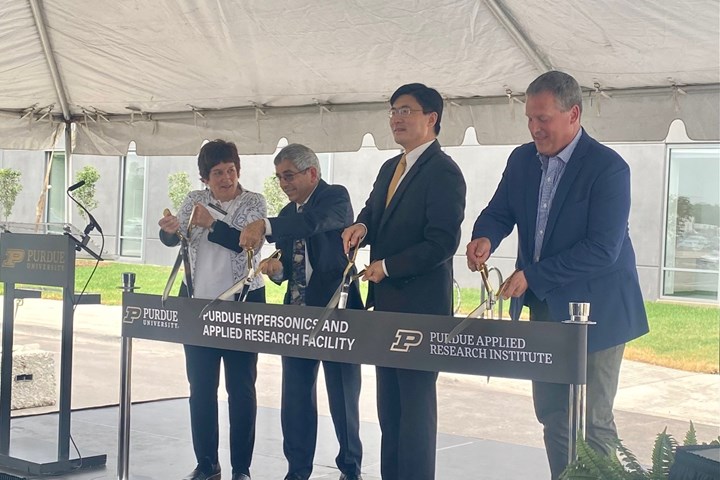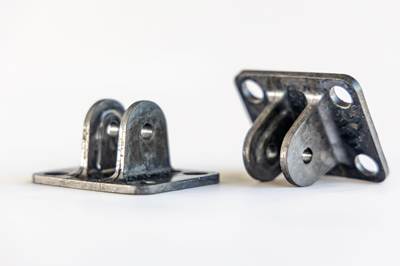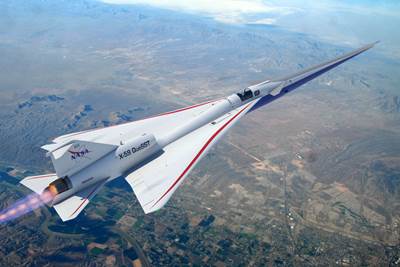Purdue opens $41 million Hypersonics and Applied Research Facility
A dedicated 65,000-square-foot building is home to Mach 8 and HYPULSE wind tunnels to advance hypersonic evaluation and testing, and the HAMTC for materials and manufacturing work with partners.
Share
Leaders in defense and national security Purdue University cut the ribbon on the new Hypersonics and Applied Research Facility. Photo Credit: Purdue University via Twitter
The Purdue Applied Research Institute (PARI), the applied research arm of Purdue University, West Lafayette, Ind., U.S., has officially opened a new facility dedicated to enhancing Purdue’s capabilities in hypersonics evaluation and testing.
Leaders from Purdue, federal government and industry joined PARI leadership and staff in celebrating the opening of the Hypersonics and Applied Research Facility (HARF), a $41 million, 65,000-square-foot building that is home to two cutting-edge wind tunnels — a Mach 8 quiet wind tunnel that is reported to be the only one in the world, and the hypersonic pulse (HYPULSE) reflected shock/expansion tunnel.
The facility is also home to the Hypersonics Advanced Manufacturing Technology Center (HAMTC), a single location for industry partners to work on materials and manufacturing innovations and provide access to testing capabilities.
“The Hypersonic Applied Research Facility is an investment in test and evaluation and research capabilities that this country desperately needs,” says Mark Lewis, CEO for PARI. “Through facilities such as HARF, we will help solve some of the most challenging and relevant problems in the field of high-speed flight while also building the future workforce.”
At HAMTC, located in HARF, researchers can collaborate with industry partners to develop materials and manufacturing innovations.
The tunnels recreate different scenarios, such as spacecraft re-entry or missile flight through the atmosphere, as well as replicating unique engine conditions for high-speed propulsion. The Mach 8 quiet wind tunnel and the HYPULSE tunnel offer controlled environments to research several facets of high-speed flight. The wind tunnel more closely simulates flight and provides more accurate data than conventional hypersonic wind tunnels.
The HYPULSE tunnel uses a shock wave of high-temperature air to recreate specific hypersonic flight conditions. It enables flight simulations at speeds ranging from Mach 5 to as high as Mach 40. Purdue will be only the second U.S. university to offer HYPULSE test capabilities.
At HAMTC, located in HARF, researchers can collaborate with industry partners to develop materials and manufacturing innovations. HAMTC is said to be the only vertically integrated prototyping center in the nation that enables the design, manufacture, joining and testing of hypersonic components and subsystems in one location, speeding time from concept to full-fledged product.
The building is located in Discovery Park District at Purdue, the university’s ever-growing mixed-use innovation hub adjacent to campus, which also includes the Maurice J. Zucrow Laboratories, and is the current or future home to co-located companies such as Rolls-Royce, Saab, Schweitzer Engineering Laboratories and Stratolaunch, which recently established its Advanced Program Office at Convergence Center.
“What’s important in a (peer competitor) race is going fast, and that’s not just flying high, far and fast, like we at Stratolaunch like to do. It is developing those systems quickly, and that only happens when you have a synergistic combination of design tools, ground test facilities, conceptual design capability and then flight test validation,” says Joshua Stults, senior director for advanced programs at Stratolaunch. “Here at Purdue, we’re able to find that synergy, build on the strong basis of ground test facilities that are being invested in here in Indiana and then go build and fly the aircraft.”
HARF will also be a training ground for students interested in careers in hypersonic research, adding capacity and expanding opportunities for students to get hands-on experiential learning opportunities. Already, more than 100 undergraduate and graduate students work with expert researchers to design, test and evaluate equipment in real-world conditions.
“Students will be involved with research at HARF in almost every step of the way,” adds Lewis. “Universities aren’t just places that present new knowledge, they’re places that create new knowledge, and students are essential to that. One of the things you see here at Purdue is that students at all levels — PhD, graduate and undergraduate students — are involved in research directly and will be involved directly in the activities at HARF.”
Related Content
Next-generation airship design enabled by modern composites
LTA Research’s proof-of-concept Pathfinder 1 modernizes a fully rigid airship design with a largely carbon fiber composite frame. R&D has already begun on higher volume, more automated manufacturing for the future.
Read MoreA new era for ceramic matrix composites
CMC is expanding, with new fiber production in Europe, faster processes and higher temperature materials enabling applications for industry, hypersonics and New Space.
Read MoreThe potential for thermoplastic composite nacelles
Collins Aerospace draws on global team, decades of experience to demonstrate large, curved AFP and welded structures for the next generation of aircraft.
Read MorePEEK vs. PEKK vs. PAEK and continuous compression molding
Suppliers of thermoplastics and carbon fiber chime in regarding PEEK vs. PEKK, and now PAEK, as well as in-situ consolidation — the supply chain for thermoplastic tape composites continues to evolve.
Read MoreRead Next
9T Labs, Purdue University to advance composites use in structural aerospace applications
Partnership defines new standard of accessibility to produce 3D-printed structural composite parts as easily as metal alternatives via Additive Fusion Technology, workflow tools.
Read MoreDigital design, multi-material structures enable a quieter supersonic NASA X-plane
NASA’s composites-intensive X-59 QueSST experimental aircraft is set for its first flight by the end of 2022, after nine years of design, manufacture, assembly and testing by Lockheed Martin Skunk Works.
Read MoreVIDEO: High-volume processing for fiberglass components
Cannon Ergos, a company specializing in high-ton presses and equipment for composites fabrication and plastics processing, displayed automotive and industrial components at CAMX 2024.
Read More



























